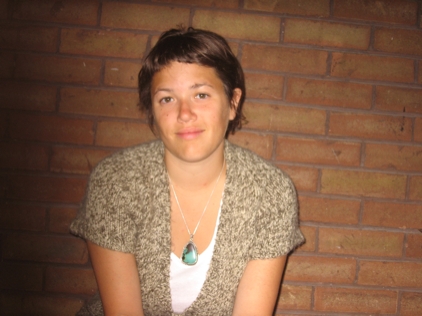

Vivian Belik is a local writer and art appreciatrice who calls Winnipeg's inner city home. A recent graduate of the University of Winnipeg, Vivian is interested in civic politics and urban issues. When she is not writing or imagining a healthier vision for her city she enjoys exploring by bicycle the forgotten treasures of Winnipeg's downtown area. This fall she is attending Dalhousie University to study journalism.
Response to Home Sweet Home by Vivian Belik
Couched in Symbolism: An art piece stirs thoughts of home and homelessness
By Vivian Belik
A red couch is perched at the corner of Main Street and Alexander, demanding the attention of those around; motorists turn to look at its striking colour and pedestrians hesitantly approach the couch, unsure of whether to take the invitation to sit or not. Emblazoned across the front of the twelve foot couch in white, block-lettering is ‘Home Sweet Home - Do Not Remove Me’, haunting words that strike a chord with residents of this inner-city community.
Created by Winnipeg artist Pat Aylesworth, ‘Home Sweet Home' explores the gentrified spaces of Winnipeg's downtown. Using an interactive piece of art, a reupholstered red couch, Aylesworth sets out to reclaim the parts of the inner city where she sees the displacement of people occurring. Over the course of a day Aylesworth positions her couch in three different locations: the front lawn of the University of Winnipeg; the corner of Main Street and Alexander; and the sidewalk directly in front of City Hall.
At its various locations in the inner city the couch is transformed into more than just a piece of furniture; it builds a sense of community between strangers who choose to sit next to each other on it. At the University of Winnipeg, with the grey-slate towers of Wesley Hall looming behind, students sit on the couch and discuss how the University's expansion has been pushing low-income residents out of the Spence neighbourhood. The image of the couch juxtaposed by the early-morning parade of cars and pedestrians on their way to work gives passersby pause for thought. It is a reminder that many of the people living on the streets of Winnipeg do not have jobs or homes to rush off to and may spend much of their day stationed at the same street corner.
At Main and Alexander the couch is a blatant reminder to those who view the installation that 'home' is a relative concept in this part of the city. A man from the neighbourhood wanders by the couch and is spurred to talk about the choices he has made in his life and his decision not to live on the street. Few people from the community choose to sit on the couch when it is placed at this street corner - just a young couple who sit and hold hands looking out at the traffic. Perhaps these pedestrians are wary of lingering too long or feel as though they have not been invited to sit down. The motorists, on the other hand, peer at the peculiar sight on Main Street from the safety of their cars, the couch receiving more attention than any homeless person at this corner ever would. Whether the message of the couch is impressed upon the motorists is unclear; they drive away from this forgotten street corner as quickly as they came.
At its final location outside of City Hall the couch catches the eye of the very people who are responsible for the laws which lead to the displacement and gentrification of residents in the downtown. From a hidden office in the bowels of City Hall comes an order from the mayor to remove the couch from its position beneath the flag poles on Main Street. What follows is a heated discussion between a city worker who has been directed to remove the couch and a citizen defending his right to be seated on a couch outside of this public institution. Treated no differently from a homeless person in the inner city, the couch is uprooted and relocated from the entrance of City Hall so it will not reflect poorly on the city. Although the mayor likely does not realize it, his request is an ironic one and is evidence of a government that is interested in protecting the rights of its citizens only when it benefits from doing so.
By choosing not to alert city and university officials of her art installation, Aylesworth was able to observe in an unfiltered manner how people interacted with her piece. Fluid and open to interpretation, the couch led to a range of responses from people.
People were most taken by the couch's ability to generate discussion between friends and strangers in public spaces. The unusual appearance of the red couch in the middle of the sidewalk was, in itself, a conversation starter; people were shaken from their daily routines and were prompted to talk to one another about the sight of the aesthetically-pleasing couch. Why was it there and what message was it sending? Pedestrians and motorists were forced to take notice of the issue of homelessness because it had been presented to them in a manner that was creative and out of context. It was an example of how art can address important political issues by appealing to people's humanity rather than through logic alone.
What is most interesting perhaps is that the couch was able to breed a sense of community while it simultaneously commented on the character of community – especially one that denies its most vulnerable citizens a place to live. Providing more than just an area to sit, the couch reminded citizens about the importance of home and what it means to be homeless in Winnipeg’s inner city.

